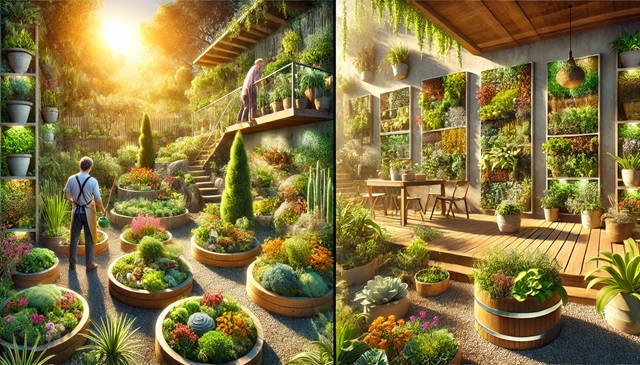Online Class: How to Decorate a Room

no certificate
with CEU Certificate*
-
14Lessons
-
24Exams &
Assignments -
1,750Students
have taken this course -
9Hours
average time -
0.9CEUs
Course Description
Unveiling Your Inner Decorator: Crafting Spaces that Resonate and Inspire
Embark on a transformative journey from novice to connoisseur with our meticulously curated course, "How to Decorate a Room". It's not just about placing furniture or painting walls; it's about weaving your essence into a space, making it uniquely yours. From elemental principles to niche design hacks, this course is a tapestry of time-tested methodologies and innovative concepts, all geared towards helping you create spaces that echo your soul.
Course Highlights:
-
Foundational Flourishes: Dive deep into the basics of design. Demystify color theory, harness the magic of different lighting moods, and master the art of floor planning with our hands-on, intuitive approach.
-
Styling Spectrum: Explore a pantheon of design styles, from the timeless allure of Victorian Romance and the tranquil vibes of Relaxed Pastoral, to the breezy notes of Beachside Chic and the opulent allure of Sophisticated Glamour. Understand the ethos, historical nuances, and defining elements of each style.
-
Practical Panache: Whether you're crafting a haven on a shoestring budget or navigating the challenges of an unconventional room layout, we've got actionable tips and tricks to ensure your decor dreams don't get compromised.
-
Decorating Deep Dives: Engage with specialized modules that tackle specific design challenges – be it infusing life into a space with greenery, evading an overly formal ambience, or weaving a sensory experience that tantalizes every sense – sight, sound, touch, smell, and even taste.
-
Personalization Paradigm: While we provide you the tools and templates, we champion your individuality. Our course empowers you with the know-how and then encourages you to remix, re-imagine, and reinvent to suit your unique narrative.
-
Elevate and Inspire: This course isn't just about learning; it's about sparking creativity. Post-course, you won't just be equipped to transform rooms, you'll be invigorated, seeing potential in every corner, every nook of your home.
Perfect for budding decorators seeking direction, or seasoned enthusiasts yearning for a fresh perspective, "How to Decorate a Room" is more than a course; it's a movement. One that celebrates design not as mere aesthetics, but as a medium of self-expression. Enroll today, and let's paint your decor dreams into reality!
Course Motivation
For some people, decorating is intimidating: choosing the right color, furniture, and accents from a plethora of choices to achieve a desired look can be overwhelming. However by working through the fundamental elements of a decorating project with a particular theme in mind, any room can be styled into an aesthetically pleasing space.
GATHERING INSPIRATION: WHAT BEST EXPRESSES YOUR STYLE?
Inspiration comes from the world around us. Look for photos, objects, textures, paint samples, and pieces of fabric that you love. Save images in a digital or physical folder, whatever works best for you.
Once you've amassed a decent sized collection, find similarities and underlying style elements to determine a personal style.
Here's a "cheat sheet" to help articulate element choices:
-
Color palettes: bold, rich tones; bright shocking colors; neutrals; warm or cool tones; stripes; patterns
-
Furniture lines: sleek and simple; rounded and commanding; intricate detailing
-
Overall room wow factors: surprising elements; one large impressive focal point
-
Textures: coarse; smooth; shiny; soft
-
Lighting: bright; candlelit; colored lights
-
Miscellaneous descriptions: delicate; organized clutter; masculine; a particular decade; cozy; durable; whimsical; plush; preppy
Are you drawn toward nautical elements or lots of lace and intricate details? Do you choose images with sparse rooms? Assign names to what you steer towards, like "beach vacation," "delicate romance," and "clean-cut modern." Don't worry if you end up with a long list, you can always combine styles in a room, for example... a romantic modern bedroom with a beach feel.
A final option, especially in a home filled with people of varying styles, is to decorate each room in a particular style, but include an underlying theme to retain cohesiveness within the home. For example, you are drawn to a sparse, modern style with a neutral color palette, but your spouse likes a traditional style with rich colors. Decorate your individual spaces primarily in your styles, but use elements of the other's style. In your modern home office, include a traditional hutch for file storage, painted in a muted red.
You can also agree on a third style then infuse those elements throughout the rooms, for example adding retro style touches in your traditionally styled living room and modern styled kitchen. We'll discuss elements of various styles in Lessons 3-14, so you'll know what to look for to achieve numerous styles.
*CONFIDENCE CHECK: Still afraid you're creating a decorating nightmare? Don't worry, this course is designed to build your confidence in choosing complementary decorating elements. You'll encounter sections entitled "Surprising Fit" where we'll discuss how seemingly opposite styles work well together. Additionally, within each lesson where a particular style is discussed you'll learn techniques for working with various design elements.
ROOM USAGE: WHAT FUNCTION WILL THE SPACE SERVE?
No matter how beautifully decorated a room is, it fails its purpose if it lacks functionality. Functionality comes from the furniture type and arrangement, lighting, and even colors.
Approaching functionality with a checklist helps ensure all bases are covered:
1) Define what the room will be used for: entertaining, sleeping/relaxing, entryway, etc.
2) Analyze what has been working, what doesn't work, and what needs fixing.These items will be the highlighted functionality points. A decorating project won't be complete without addressing these issues. For example, the current couch is too small for the whole family to lounge on, storage is sparse in a perpetually messy office, or the speakers need adjustment to listen to music in both the kitchen and dining room.
3) For some rooms, deciding on a color scheme in consideration with functionality will help achieve a certain mood. Color psychology reveals colors play a role in elevating particular moods. Corals and vibrant oranges are energizing, buttercup yellow is cheerful, while grays and taupes can be calming. Decide on the desired moods for each room and choose colors accordingly.
Once these three items are decided upon, it's time to get to work arranging furniture and choosing lighting.
*DECORATING TIP If you really love a certain color, consider adjusting the tone to be more aligned with the mood you'd like to achieve. A bright red bedroom might be too energizing for some people to sleep soundly, but a deeper red might be just the right shade to encourage sweet dreams.
FLOOR PLAN: HOW WILL EVERYTHING FIT?
Addressing the flow of a room requires the correct size and placement of furniture. There are two ways to determine how the flow will work with the furniture arrangement: move everything around, or, the easier option, make a diagram.
1) Grab some graph paper, a ruler, pencil, and measuring tape. Measure the room.
2) Determine the scale conversion, then draw out the overhead dimensions of the room on the graph paper, as if you were peering into the room from the ceiling. An easy conversion for smaller rooms is 1 inch equals 1 foot, for larger rooms utilizing the graph's paper blocks keep everything on one page, for example 2 squares equals 1 foot. Regardless of the chosen scale, be sure to apply the same scale to the furniture, windows, and doorways.
3) Annotate the location and dimensions of doorways and windows within the graphed room to include the arc of swinging doors. Also note the window height from the floor.
4) Next, measure all the furniture you plan on keeping in the room. Feel free to consider pieces from other rooms that might fit better in the room-in-progress. Draw out dimensions on a piece of graph paper, then carefully cut them out. Remember, only draw overhead viewings of each piece. Keep in mind expansive space, that is the space that furniture "grows" into: recliners, opened desk drawers, and pulled out chairs around a table.
5) Lay the furniture pieces on the graphed room and feel free to rearrange. Keep in mind walking paths through the room, seating for optimal conversation, and the previously mentioned expansive space. This step helps determine how big of a couch can be purchased, the optimal sized rug, or discover an old dining room table will work perfectly as an oversized office desk.
The same method of graphing can be utilized to envision furniture around larger windows or a unique architectural focal point. Simply include the height measurements of every item, and depict the graphed image from a side view. It should resemble the view from standing in front of the wall in question.
Drawing out a floor plan will save time and energy in physically moving heavy items. With the ease of moving paper pieces you might even discover a new furniture arrangement, stay open to possibilities!
*DECORATING TIP Many people swear by the ancient Chinese practice of Feng Shui. The concept requires arranging furniture and objects to manipulate positive and negative energies (Chi) within a house. From a practicality stand point, the idea of Chi flow goes hand in hand with the movement of bodies, or how an individual will navigate through and within rooms.
LIGHTING: HOW MUCH LIGHT DO YOU WANT?
Lighting within a room is important for both functionality and setting a mood. Bright lights in a kitchen are practical while softer lights in a bedroom are ideal, and the option to adjust lights in a family room helps boost the room's functionality. Light comes from four main sources: overhead electric and wall sconces, lamps, candles, and windows. Each of these sources can be manipulated to a certain extent to take advantage of its lighting capacity and make up for shortfalls in weaker sources.
- Overhead electric lights and wall sconces are built-in to a home's wiring system. They can be embedded into the ceiling, drop down like a chandelier, or be attached to a ceiling fan. The light can be adjusted through lightbulbs (softer or brighter, even colored), shades (in drop down wiring), and by installing dimmer switches.
- Lamps offer flexibility in choosing a room's light concentration. Specialized task lamps or strips are perfect for reading nooks or underneath kitchen cabinets. Switching out lamp shades and bulbs adjusts the brightness of the lamp's light as well as plays a role in the overall decorating style. The only limits with lamps are the number of surfaces to place them upon, and plugs to energize them.
- Candles provide a great ambiance solution for a room with bright light. A collection of votives as a centerpiece and scattered around a room create a soft light perfect for entertaining. Keep in mind fire safety when lighting lots of candles and be sure to place lit candles on sturdy surfaces away from flammable objects and fabrics.
- Windows are natural light distributors. Curtains and blinds serve to decorate and decrease the amount of light and/or view into a room. When decorating a room note what direction the windows face and if any trees or bushes block the natural light. From there, it's easy to decide if heavier curtains are a must to block morning light in a bedroom, or sheer drapes and an extra lamp will boost an office's functionality. Other considerations include opaque coverings in bathrooms (they don't actually manipulate the light but do boost privacy), the ability to block sun glare on TV and computer screens, and maximizing natural light to help decrease the electric bill.
Utilize all four sources of light for the utmost decorating advantage. If a budget restricts big changes like installing a new overhead light or window, make easier changes to the other sources like new lightbulbs or lighter curtains.
Light itself might not seem like a large component in decorating as attention usually goes towards an actual lamp or curtain fabric, however utilizing light properly will boost the room's functionality and ambiance. In the end, it showcases the room's overall style.
BUDGET MONEY AND TIME: HOW MUCH OF EACH CAN YOU SPEND?
After understanding the fundamentals of designing, turning inspiration into a beautifully styled room is a matter of money and time. Money often holds people back, however there are numerous ways around budget problems, we'll discuss a few in depth in Lesson 2. For now, determine the room's set budget and work within the constraints.
1) What is the maximum budget? Write it down. Within the maximum budget, allocate funds for each portion of decorating: painting, furniture, storage, final touches, lighting, etc. Always consult the budget, but maintain flexibility within the allocations (See #4).
2) Address the functionality issues first and foremost. What, if anything, needs to be purchased or fixed? How much will it cost? In Lesson 2 we'll discuss wallet friendly solutions, consider those options in your pricing list.
3) Shop around for objects, furniture, fabrics, and everything else to achieve the room's overall style. Avoid purchasing big ticket items on first visits, merely browse and make notes. If you're still thinking about that dresser a week later, it's the one.
4) Sacrifice when applicable. Changing the look of a room doesn't necessarily mean spending a lot of money, however sometimes it's worth purchasing a sturdy, quality piece over a flimsy one. Give and take rationally. For example, in a home office, a heavy, well-made desk can take a large chunk of the budget, but will last for many years, and more importantly, become a beloved piece. Make the large purchase then scrimp on other areas such as cheaper storage boxes and painting existing shelves instead of purchasing new ones.
5) Don't feel pressured to buy everything at once. Extend a decorating project over a few weeks or months. Take care of cheaper changes right away while saving for larger purchases, or work on the inspiration and planning phases while saving designated decorating money.
Decorating on a budget doesn't have to feel restraining: simply approach the budget rationally and within limits for each area in mind. Look for money saving opportunities and don't be afraid to get dirty fixing or building something. Cutting costs may mean devoting more time to the overall project, which is another constraint some people find difficult to deal with when decorating.
It's not a race to complete any decorating project, however having an unfinished bedroom for months on end can become frustrating. Plan a project timeline by annotating each phase of the decorating project to include estimated hours. Then consult a calendar and schedule each task.
A few steps from a project timeline can resemble this:
1) Measure and arrange office floor plan. Time: 3 hours, this Saturday morning.
2) Determine color scheme and purchase paint supplies. Time: 2 hours (includes driving to store). Tuesday after work.
3) Empty room, paint walls and book shelves. Time: 8 hours, next Saturday, all day.
The more specific in your task descriptions, the better. Also, don't be afraid to break down larger tasks even further, for example spending two mornings instead of one day painting. Finally, use actual dates for better scheduling, and include "catch up" days is your schedule is prone towards fluctuating.
For go-getters, finding time to check off an item prior to its scheduled date helps moves a decorating project along. However don't rush through tasks simply to check off the boxes. Do tasks correctly, especially painting, fixing, or building projects, even if it means spending more time than estimated. Doing it correctly the first time saves the trouble of going back and spending more time correcting errors.
Finally, be realistic about the project timeline, and figure out ways to stick with it. Some ideas include planning an unveiling party for a family room or kitchen, or schedule a pampering day as a reward for completing a bedroom or home office. Looking forward to showing off your hard work or basking in relaxation can be the spur some people need to finish their decorating to-do lists. One final tip: plan to knock out the time consuming or unappealing portions of the project first, when you have the most motivation. Once the hard stuff is done, like cleaning out clutter or emptying a room for painting, you can enjoy the fun decorating portion.
- Completely Online
- Self-Paced
- Printable Lessons
- Full HD Video

- 6 Months to Complete
- 24/7 Availability
- Start Anytime
- PC & Mac Compatible
- Android & iOS Friendly
- Accredited CEUs

Course Lessons
Lesson 1: Introduction
 Lesson 1 Video
Lesson 1 Video Lesson discussions: Reasons for Taking this Course
Lesson discussions: Reasons for Taking this Course Complete: Introduction Assignment
Complete: Introduction Assignment Complete: Assignment 1: What's My Style?
Complete: Assignment 1: What's My Style? Assessment: Exam 1
Assessment: Exam 1
Lesson 2: Problem Solving
 Lesson 2 Video
Lesson 2 Video Complete: Assignment 2: Color Wheels
Complete: Assignment 2: Color Wheels Assessment: Exam 2
Assessment: Exam 2
Lesson 3: Decorating in Greco-Roman Style
 Lesson 3 Video
Lesson 3 Video Assessment: Exam 3
Assessment: Exam 3
Lesson 4: Decorating in Aristocratic Romance Style
 Lesson 4 Video
Lesson 4 Video Complete: Assignment 4: Marrying Styles
Complete: Assignment 4: Marrying Styles Assessment: Exam 4
Assessment: Exam 4
Lesson 5: Decorating in Relaxed Pastoral Style
 Lesson 5 Video
Lesson 5 Video Assessment: Exam 5
Assessment: Exam 5
Lesson 6: Decorating in a Tuscan Simplistic Style
 Lesson 6 Video
Lesson 6 Video Assessment: Exam 6
Assessment: Exam 6
Lesson 7: Decorating in a Minimalistic Japanese Style
 Lesson 7 Video
Lesson 7 Video Assessment: Exam 7
Assessment: Exam 7
Lesson 8: Decorating Inspired by Safaris
 Lesson 8 Video
Lesson 8 Video Complete: Assignment 8: Focal Point
Complete: Assignment 8: Focal Point Assessment: Exam 8
Assessment: Exam 8
Lesson 9: Decorating Inspired by Indian Spices
 Lesson 9 Video
Lesson 9 Video Assessment: Exam 9
Assessment: Exam 9
Lesson 10: Decorating in Clean Modern Style
 Lesson 10 Video
Lesson 10 Video Complete: Assignment 10: Functional Designing
Complete: Assignment 10: Functional Designing Assessment: Exam 10
Assessment: Exam 10
Lesson 11: Decorating a Beachside Chic Room
 Lesson 11 Video
Lesson 11 Video Complete: Assignment 11: Costal Elements
Complete: Assignment 11: Costal Elements Assessment: Exam 11
Assessment: Exam 11
Lesson 12: Decorating an Industrial Style Room
 Lesson 12 Video
Lesson 12 Video Assessment: Exam 12
Assessment: Exam 12
Lesson 13: Decorating with Organic Influence
 Lesson 13 Video
Lesson 13 Video Complete: Assignment 13: Bringing Nature Into a Room
Complete: Assignment 13: Bringing Nature Into a Room Assessment: Exam 13
Assessment: Exam 13
Lesson 14: Decorating a Sophisticated Glamour Styled Room
 Lesson 14 Video
Lesson 14 Video Lesson discussions: Course Completion Poll: Your Thoughts; Course Comments; Program Evaluation Follow-up Survey (End of Course)
Lesson discussions: Course Completion Poll: Your Thoughts; Course Comments; Program Evaluation Follow-up Survey (End of Course) Complete: Assignment 14: Your Favorite Style(s)
Complete: Assignment 14: Your Favorite Style(s) Assessment: Exam 14
Assessment: Exam 14 Assessment: The Final Exam
Assessment: The Final Exam
Learning Outcomes
- Describe decorating in greco-roman style.
- Describe decorating in aristocratic romance style.
- Describe decorating in relaxed pastoral style.
- Describe decorating in a Tuscan simplistic style.
- Describe decorating in a minimalistic Japanese style.
- Describe decorating inspired by safaris.
- Summarize decorating inspired by Indian spices.
- Summarize decorating in clean modern style.
- Describe decorating with organic influence.
- Describe decorating a sophisticated glamour styled room.
- Demonstrate mastery of lesson content at levels of 70% or higher.
Additional Course Information

- Document Your Lifelong Learning Achievements
- Earn an Official Certificate Documenting Course Hours and CEUs
- Verify Your Certificate with a Unique Serial Number Online
- View and Share Your Certificate Online or Download/Print as PDF
- Display Your Certificate on Your Resume and Promote Your Achievements Using Social Media

Choose Your Subscription Plan
No Certificate / No CEUs
This course only
| Includes certificate | X |
| Includes CEUs | X |
| Self-paced |

|
| Instructor support |

|
| Time to complete | 6 months |
| No. of courses | 1 course |
Certificate & CEUs
This course only
| Includes certificate |

|
| Includes CEUs |

|
| Self-paced |

|
| Instructor support |

|
| Time to complete | 6 months |
| No. of courses | 1 course |
Certificates & CEUs
Includes all 600+ courses
| Includes certificate |

|
| Includes CEUs |

|
| Self-paced |

|
| Instructor support |

|
| Time to complete | 12 Months |
| No. of courses | 600+ |
Certificates & CEUs
Includes all 600+ courses
| Includes certificate |

|
| Includes CEUs |

|
| Self-paced |

|
| Instructor support |

|
| Time to complete | 24 Months |
| No. of courses | 600+ |
Student Testimonials
- "I found this course to be well organized, simple to follow, and chock full of useful information. It was very helpful for me, and I learned a lot." -- Gagne A.
- "This is an amazing course. I never expected to learn so much. I thought that I've heard about most decoration styles and here i found several pleasant surprises." -- Diana R.
- "I really liked the part where styles were combined. While no one style jumped out at me on its own, the combining of styles really got me thinking about my own home and its rooms!" -- Dana H.
- "It was very helpful and a lot of fun!!" -- Nikki G.
- "Very organized and professional." -- Ivian A.
Related Courses
-
 45 hours
4.5 CEUs
Event Management Course Bundle
+ More Info
45 hours
4.5 CEUs
Event Management Course Bundle
+ More Info
-
 17 hours
1.7 CEUs
Mixed Media Art
+ More Info
17 hours
1.7 CEUs
Mixed Media Art
+ More Info
-
 9 hours
0.9 CEUs
How to Decorate a Room
+ More Info
9 hours
0.9 CEUs
How to Decorate a Room
+ More Info
-
 5 hours
0.5 CEUs
Starting Your Own Cleaning Business
+ More Info
5 hours
0.5 CEUs
Starting Your Own Cleaning Business
+ More Info
-
 2 hours
0.2 CEUs
How to Care for House Pets
+ More Info
2 hours
0.2 CEUs
How to Care for House Pets
+ More Info
-
 14 hours
1.4 CEUs
Candle Making 101
+ More Info
14 hours
1.4 CEUs
Candle Making 101
+ More Info
-
 11 hours
1.1 CEUs
Professional Organizer Training
+ More Info
11 hours
1.1 CEUs
Professional Organizer Training
+ More Info
-
 9 hours
0.9 CEUs
Watercolor Painting 101
+ More Info
9 hours
0.9 CEUs
Watercolor Painting 101
+ More Info
-
 5 hours
0.5 CEUs
Catering 101
+ More Info
5 hours
0.5 CEUs
Catering 101
+ More Info
-
 13 hours
1.3 CEUs
How To Draw 101
+ More Info
13 hours
1.3 CEUs
How To Draw 101
+ More Info
-
 7 hours
0.7 CEUs
Microsoft Excel Level 2
+ More Info
7 hours
0.7 CEUs
Microsoft Excel Level 2
+ More Info
-
 10 hours
1.0 CEUs
Interior Design 101
+ More Info
10 hours
1.0 CEUs
Interior Design 101
+ More Info
-
 13 hours
1.3 CEUs
Image Consultant
+ More Info
13 hours
1.3 CEUs
Image Consultant
+ More Info
-
 4 hours
0.4 CEUs
Etiquette for Children and Teens
+ More Info
4 hours
0.4 CEUs
Etiquette for Children and Teens
+ More Info
-
 9 hours
0.9 CEUs
Event Planning 101
+ More Info
9 hours
0.9 CEUs
Event Planning 101
+ More Info
-
 7 hours
0.7 CEUs
Wedding Traditions Around the World
+ More Info
7 hours
0.7 CEUs
Wedding Traditions Around the World
+ More Info
-
 9 hours
0.9 CEUs
Landscaping 101
+ More Info
9 hours
0.9 CEUs
Landscaping 101
+ More Info
-
 12 hours
1.2 CEUs
Wedding Planning 101
+ More Info
12 hours
1.2 CEUs
Wedding Planning 101
+ More Info
-
 5 hours
0.5 CEUs
Bread Baking 101
+ More Info
5 hours
0.5 CEUs
Bread Baking 101
+ More Info
-
 8 hours
0.8 CEUs
Special Events Planning
+ More Info
8 hours
0.8 CEUs
Special Events Planning
+ More Info
-
 6 hours
0.6 CEUs
Etiquette Consultant
+ More Info
6 hours
0.6 CEUs
Etiquette Consultant
+ More Info
-
 7 hours
0.7 CEUs
Etiquette 101
+ More Info
7 hours
0.7 CEUs
Etiquette 101
+ More Info
-
 7 hours
0.7 CEUs
Clutter Control 101
+ More Info
7 hours
0.7 CEUs
Clutter Control 101
+ More Info
-
 11 hours
1.1 CEUs
Cooking and Baking 101
+ More Info
11 hours
1.1 CEUs
Cooking and Baking 101
+ More Info
-
 15 hours
1.5 CEUs
Western Calligraphy
+ More Info
15 hours
1.5 CEUs
Western Calligraphy
+ More Info
-
 4 hours
0.4 CEUs
How to Bake Cookies
+ More Info
4 hours
0.4 CEUs
How to Bake Cookies
+ More Info
-
 14 hours
1.4 CEUs
Cake Decorating 101
+ More Info
14 hours
1.4 CEUs
Cake Decorating 101
+ More Info
-
 5 hours
0.5 CEUs
Home Safety
+ More Info
5 hours
0.5 CEUs
Home Safety
+ More Info
-
 14 hours
1.4 CEUs
Acrylic Painting 101
+ More Info
14 hours
1.4 CEUs
Acrylic Painting 101
+ More Info
-
 6 hours
0.6 CEUs
Introduction to Gardening
+ More Info
6 hours
0.6 CEUs
Introduction to Gardening
+ More Info








